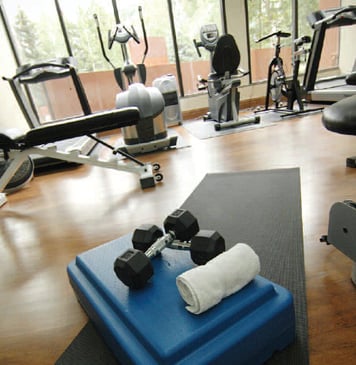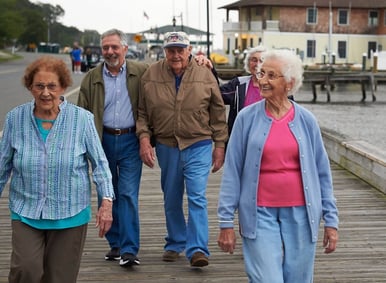 Clients regularly ask me whether we have any recommendations or contacts for certain exercise equipment, or if we have any successful models in place for collaborating with rehab departments or cafeteria vendors. The bulk of our contacts in the world of fitness are with current clients where we have our professional staff on the ground managing their fitness program, or with consulting clients where we are providing support and resources to enhance their existing program. However, we also have a large network of industry contacts that we partner with, allowing us to (1) provide the quality service we do to our clients and (2) support other businesses outside of a client setting.
Clients regularly ask me whether we have any recommendations or contacts for certain exercise equipment, or if we have any successful models in place for collaborating with rehab departments or cafeteria vendors. The bulk of our contacts in the world of fitness are with current clients where we have our professional staff on the ground managing their fitness program, or with consulting clients where we are providing support and resources to enhance their existing program. However, we also have a large network of industry contacts that we partner with, allowing us to (1) provide the quality service we do to our clients and (2) support other businesses outside of a client setting.
Once clients experience the ease of replacing their cardio equipment or launching a multi-vendor wellness initiative with our support, they recognize the added value that expertise brings to the partnership they have with NIFS. I love seeing clients supported on both sides—with our passionate staff on the ground in their fitness center serving their members, as well as with our administrative support helping guide their leadership team’s decision-making on broader facility and program needs.
Read on to learn about the relationships we build and the scope of our reach in supporting clients in 14 states across the US.
- Equipment vendors: From balance and fall-prevention equipment, to group fitness supplies, to the latest trends in strength-training equipment, we have vendor partners across the US who help us find equipment solutions to meet our clients’ needs. For our senior living clients, we know which manufacturers have equipment that meets the unique needs of an active older adult population. For our corporate clients, we have partners who outfit facilities across the US with the latest and greatest equipment to create a welcoming and inspiring space for your employees. Not to mention, the relationships we have with equipment manufacturers provides us with national buying power, which we can pass along to our clients.
- Architect and design firms: Particularly in a senior living setting where strong emphasis on quality, high-end fitness amenities for the aging population is on the rise, forward-thinking architects and designers reach out to us for consulting support on how to create a truly functional space that will best support a strong program when renovations or new construction are complete. These firms benefit from our end-user perspective, and we often pick up on some new ideas to file away in our bank of resources for future projects with clients.
- Client vendors: At the site level, our staff regularly partners with other health and wellness vendors on campus to effectively bridge programs and services for their members. We work closely with rehab providers, cafeteria vendors, registered dietitians, employee health services, and many more. Some of these providers have a similar reach as we do in their profession across the US, and others are local providers, but we build strong connections with all to best serve our clients.
While the fitness industry can be full of fads, an ability to build strong relationships is a trend that will never go out of style and is essential for the success of any fitness program. We pride ourselves on the relationships we build with our clients, members, and vendor partners and love bridging new connections for clients to enhance their programs.


 Believe it or not, warm weather has arrived in some parts of the country, and is quickly approaching in others. As the sun peeks out from behind the clouds and nature begins to call, many older adults will be heading out the door for a walk outside. This is a very good thing, and should be encouraged for most people. Some retirement communities may even establish
Believe it or not, warm weather has arrived in some parts of the country, and is quickly approaching in others. As the sun peeks out from behind the clouds and nature begins to call, many older adults will be heading out the door for a walk outside. This is a very good thing, and should be encouraged for most people. Some retirement communities may even establish 
.jpg?width=385&name=GettyImages-482817556%20(1).jpg) The more we age, the less we move, and the more we start to take our health for granted, especially if we have been “healthy” for most of our lives. We often hear about the need to exercise more as we get older, but what about the nutrition aspect? Eating healthy foods is just as important as exercising. There are some good practices and tricks to maintaining a healthy diet and exercising plan as we age.
The more we age, the less we move, and the more we start to take our health for granted, especially if we have been “healthy” for most of our lives. We often hear about the need to exercise more as we get older, but what about the nutrition aspect? Eating healthy foods is just as important as exercising. There are some good practices and tricks to maintaining a healthy diet and exercising plan as we age.
.jpg?width=399&name=GettyImages-905905000%20(1).jpg) With the weather changing for the better and the days becoming longer, this is as good of a time as any to get the family up and moving. It has been a long winter, and most of us have fallen into boring routines of being indoors binge watching Netflix or playing video games to stay out of the cold. Finally, spring is here, so it’s time to break those boring routines and switch it up!
With the weather changing for the better and the days becoming longer, this is as good of a time as any to get the family up and moving. It has been a long winter, and most of us have fallen into boring routines of being indoors binge watching Netflix or playing video games to stay out of the cold. Finally, spring is here, so it’s time to break those boring routines and switch it up!.jpg?width=394&name=GettyImages-962782170%20(1).jpg) I keep finding more and more news stories, magazine articles, social media ads, and even store displays that contain the words “Gut Health.” 10 years or more ago, you never heard that phrase anywhere, but now it’s all the rage. So, why all the buzz? Well, it turns out that research has linked gut health to a variety of functions in your body.
I keep finding more and more news stories, magazine articles, social media ads, and even store displays that contain the words “Gut Health.” 10 years or more ago, you never heard that phrase anywhere, but now it’s all the rage. So, why all the buzz? Well, it turns out that research has linked gut health to a variety of functions in your body.